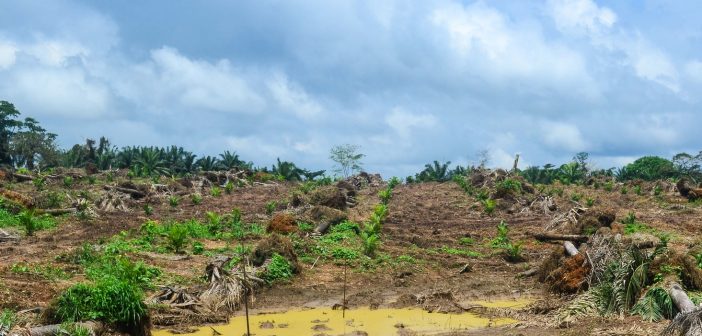(Featured image: forest in Nigeria cut down for palm oil production. Credit jbdodane, used under CC BY-NC 2.0 / cropped)
Via Duke University Office of News and Communications
DURHAM, N.C. – As palm oil production expands from Southeast Asia into tropical regions of the Americas and Africa, vulnerable forests and species on four continents face increased risk of loss, a new Duke University-led study finds.
The largest areas of vulnerable forest are in Africa and South America, where more than 30 percent of forests within land suitable for oil palm plantations remain unprotected, the study shows.
Rates of recent deforestation have been highest in Southeast Asia and South America, particularly Indonesia, Ecuador and Peru, where more than half of all oil palms are grown on land cleared since 1989.
“Almost all oil palm is grown in places that once were tropical forests. Clearing these forests threatens biodiversity and increases greenhouse gas emissions,” said Varsha Vijay, a doctoral student at Duke’s Nicholas School of the Environment who led the study.
“By identifying where the greatest extent of palm oil-driven deforestation has recently occurred and modelling where future expansion is most likely, we can guide efforts to reduce these adverse impacts,” Vijay said.
Palm oil is now the world’s most widely traded vegetable oil, according to the Food and Agriculture Organization of the United Nations. The oil, which is harvested from oil palms, and its derivatives are common ingredients in many processed foods and personal care products. As global demand grows, large swaths of tropical forest are being converted into oil palm plantations in 43 countries.
Using 25 years of high-resolution Google Earth and Landsat satellite imagery, Vijay and her team tracked the extent of this deforestation in four regions: Southeast Asia, Africa, South America and Mesoamerica, which includes Mexico, Central America and the Caribbean.
They modeled where future deforestation is most likely to occur, based on the pace of recent expansion in each region and the extent of suitable forest left unprotected there.
The team published its findings July 27 in the peer-reviewed, open-access journal PLOS ONE.
Because forests in all four regions contain high concentrations of different mammal and bird species at risk of extinction or extirpation, conservation efforts will need to incorporate strategies tailored to each region, said Stuart Pimm, Doris Duke Professor of Conservation at Duke.
“While the Amazon and Indonesia have many species of globally threatened mammals and birds, other areas such as the Congo Basin and the coastal forests of Colombia are home to species with small ranges that make them especially vulnerable to habitat loss despite not being classified as threatened or endangered,” he said. “This needs to be considered in conservation planning.”
“Many past studies have focused solely on Indonesia and Malaysia, which produce more than 80 percent of the world’s palm oil. By evaluating deforestation caused by palm oil production in 20 countries across four regions, our study demonstrates that the biodiversity impacts of this expansion are very different from country to country and region to region,” said Clinton Jenkins of the Institute for Ecological Research in Brazil.
“The palm oil industry has a legacy of deforestation, and today consumer pressure is pushing companies toward deforestation-free sources of palm oil,” noted Sharon Smith of the Union of Concerned Scientists, who co-authored the study with Vijay, Pimm and Jenkins.
“This research helps us understand where to focus on using government regulation and voluntary market interventions to shape oil palm plantation expansion in ways that protect biodiversity-rich ecosystems and prevent deforestation,” Smith said.
__
Funding for the study came from the National Science Foundation (grant #1106401).
CITATION: “Understanding the Impacts of Oil Palm on Deforestation and Biodiversity,” Varsha Vijay, Stuart L. Pimm, Clinton N. Jenkins, Sharon J. Smith, PLOS ONE, July 27, 2016; http://dx.plos.org/10.1371/





